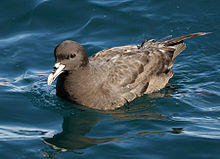| Procellaria | |
|---|---|
 | |
| White-chinned petrel (Procellaria aequinoctalis) | |
| Scientific classification | |
| Kingdom: | Animalia |
| Phylum: | Chordata |
| Class: | Aves |
| Order: | Procellariiformes |
| Family: | Procellariidae |
| Genus: | Procellaria Linnaeus, 1758 |
Procellaria is a genus of Southern Ocean long-winged seabirds related to prions, and within the order Procellariiformes. The black petrel (Procellaria parkinsoni) ranges in the Pacific Ocean, and as far north as Central America. The spectacled petrel (Procellaria conspicillata) is confined to the Atlantic Ocean, and the Westland petrel (Procellaria westlandica) to the Pacific Ocean. The white-chinned (Procellaria aequincotialis) and grey petrel (Procellaria cinerea) range throughout the higher latitudes of the Southern Ocean.
Taxonomy
The genus Procellaria was introduced in 1758 by the Swedish naturalist Carl Linnaeus in the tenth edition of his Systema Naturae.[1] The name is from the Latin procella meaning "storm" or "gale".[2] The type species was designated as the white-chinned petrel by George Robert Gray in 1840.[3][4]
The genus Procellaria is sister to the genus Bulweria containing Bulwer's petrel and Jouanin's petrel. These genera are in turn sister to a clade containing the giant petrels, the fulmars, the Cape petrel, the Antarctic petrel and the snow petrel.[5]
Species
There are five species, all of which have "petrel" in their common name.[6]
- Grey petrel, grey shearwater, or pediunker, Procellaria cinerea – breeds on subantarctic islands[7]
- White-chinned petrel, Procellaria aequincotialis – breeds on subantarctic islands[7]
- Spectacled petrel, Procellaria conspicillata – breeds on Inaccessible Island[7]
- Black petrel or Parkinson's petrel, Procellaria parkinsoni – breeds on Little Barrier Island and Great Barrier Island[7]
- Westland petrel, Procellaria westlandica – breeds on South Island[7]
Description
Procellaria is a member of the family Procellariidae and the order Procellariiformes. As members of Procellariiformes, they share certain characteristics. First they have tubular nostrils called naricorns. This feature gives them their common name, tubenoses. The opening to the nostril is located differently in some birds. These birds have the opening on top of the upper bill. Second, they produce a stomach oil that contains wax esters and triglycerides. This oil fills two functions. When predators threaten the birds or their chick or egg, they spit the substance on them. This substance has an awful smell, and mats the feathers down, degrading their usefulness. Also, they can digest the wax esters for a high energy source of food, during long flights or the period of time that they are incubating their egg or caring for their young. They also have a uniquely structured bill, with seven to nine distinct horny plates.[8] Finally, they have a salt gland that is located above their nasal passages and helps desalinate their body, as they drink seawater. They excrete the salty waste out their nose.[9]
Distribution and habitat
They range from the cold waters of the Southern Ocean to temperate waters, and are pelagic except during the breeding season.
Behaviour
These tubenoses fly like shearwaters, with stiff wings and shearing technique across wave fronts. This technique saves energy. During breeding season they utilize coastal cliffs on islands, laying their single egg in a burrow.[10]
Conservation
The conservation status of bird species are designated by BirdLife International on behalf of the International Union for Conservation of Nature. The white-chinned, spectacled and black petrel are classified as "Vulnerable", the grey petrel as "Near-threatened" and the Westland petrel as "Endangered".[11]
References
- ^ Linnaeus, Carl (1758). Systema Naturae per regna tria naturae, secundum classes, ordines, genera, species, cum characteribus, differentiis, synonymis, locis (in Latin). Volume 1 (10th ed.). Holmiae (Stockholm): Laurentii Salvii. p. 131.
- ^ Jobling, James A. (2010). The Helm Dictionary of Scientific Bird Names. London: Christopher Helm. p. 317. ISBN 978-1-4081-2501-4.
- ^ Gray, George Robert (1840). A List of the Genera of Birds : with an Indication of the Typical Species of Each Genus. London: R. and J.E. Taylor. p. 78.
- ^ Mayr, Ernst; Cottrell, G. William, eds. (1979). Check-List of Birds of the World. Volume 1 (2nd ed.). Cambridge, Massachusetts: Museum of Comparative Zoology. p. 85.
- ^ Penhallurick, John; Wink, Michael (2004). "Analysis of the taxonomy and nomenclature of the Procellariiformes based on complete nucleotide sequences of the mitochondrial cytochrome b gene". Emu. 104 (2): 125–147. doi:10.1071/MU01060.
- ^ Gill, Frank; Donsker, David; Rasmussen, Pamela, eds. (January 2021). "Petrels, albatrosses". IOC World Bird List Version 11.1. International Ornithologists' Union. Retrieved 15 February 2021.
- ^ a b c d e Clements, James (2007)
- ^ Double, M. C. (2003)
- ^ Ehrlich, Paul R. (1988)
- ^ Carboneras, C. (1992). "Family Procellariidae (Petrels and Shearwaters)". In del Hoyo, J.; Elliott, A.; Sargatal, J. (eds.). Handbook of the Birds of the World. Volume 1: Ostrich to Ducks. Barcelona, Spain: Lynx Edicions. pp. 216–257. ISBN 84-87334-10-5.
- ^ BirdLife International (2021). "Search for Procellaria". Data Zone. Retrieved 15 February 2021.
Sources
- Clements, James (2007). The Clements Checklist of the Birds of the World (6 ed.). Ithaca, NY: Cornell University Press. ISBN 978-0-8014-4501-9.
- Double, M. C. (2003). "Procellariiformes (Tubenosed Seabirds)". In Hutchins, Michael; Jackson, Jerome A.; Bock, Walter J.; Olendorf, Donna (eds.). Grzimek's Animal Life Encyclopedia. 8 Birds I Tinamous and Ratites to Hoatzins. Joseph E. Trumpey, Chief Scientific Illustrator (2nd ed.). Farmington Hills, MI: Gale Group. pp. 107–111. ISBN 0-7876-5784-0.
- Ehrlich, Paul R.; Dobkin, David, S.; Wheye, Darryl (1988). The Birders Handbook (First ed.). New York, NY: Simon & Schuster. pp. 29–31. ISBN 0-671-65989-8.